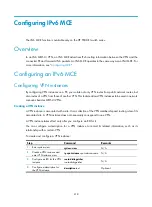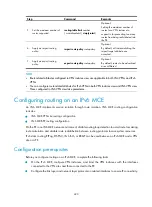
406
Step Command
Remarks
5.
Configure a filtering
policy to filter
advertised routes.
filter-policy
{
acl-number
|
ip-prefix
ip-prefix-name
|
route-policy
route-policy-name
}
export
[
isis
process-id
|
ospf
process-id
|
rip
process-id
|
bgp
|
direct
|
static
]
Optional.
By default, IS-IS does not filter
advertised routes.
6.
Return to system view.
quit
N/A
7.
Enter interface view.
interface
interface-type interface-number
N/A
8.
Enable the IS-IS process
on the interface.
isis enable
[
process-id
]
Disabled by default.
Configuring EBGP between MCE and PE
Step Command
Remarks
1.
Enter system view.
system-view
N/A
2.
Enter BGP view.
bgp
as-number
N/A
3.
Enter BGP-VPN instance
view.
ipv4-family vpn-instance
vpn-instance-name
N/A
4.
Configure the PE as the
EBGP peer.
peer
{
group-name
|
ip-address
}
as-number
as-number
N/A
5.
Redistribute the VPN
routes of the VPN site.
import-route
protocol
[
process-id
|
all-processes
] [
med
med-value
|
route-policy
route-policy-name
] *
By default, no route
redistribution is configured.
6.
Configure a filtering
policy to filter the routes
to be advertised.
filter-policy
{
acl-number
|
ip-prefix
ip-prefix-name
}
export
[
direct | isis
process-id
|
ospf
process-id
|
rip
process-id
|
static
]
Optional.
By default, BGP does not filter
the routes to be advertised.
7.
Configure a filtering
policy to filter the
received routes.
filter-policy
{
acl-number
|
ip-prefix
ip-prefix-name
}
import
Optional.
By default, BGP does not filter
the received routes.
NOTE:
BGP runs within a VPN in the same way as it runs within a public network. For more information about
BGP, see
Layer 3—IP Routing Configuration Guide.
Configuring IBGP between MCE and PE
Step Command
Remarks
1.
Enter system view.
system-view
N/A
2.
Enter BGP view.
bgp
as-number
N/A
3.
Enter BGP-VPN instance
view.
ipv4-family vpn-instance
vpn-instance-name
N/A
4.
Configure the PE as the IBGP
peer.
peer
{
group-name
|
ip-address
}
as-number
as-number
N/A






























